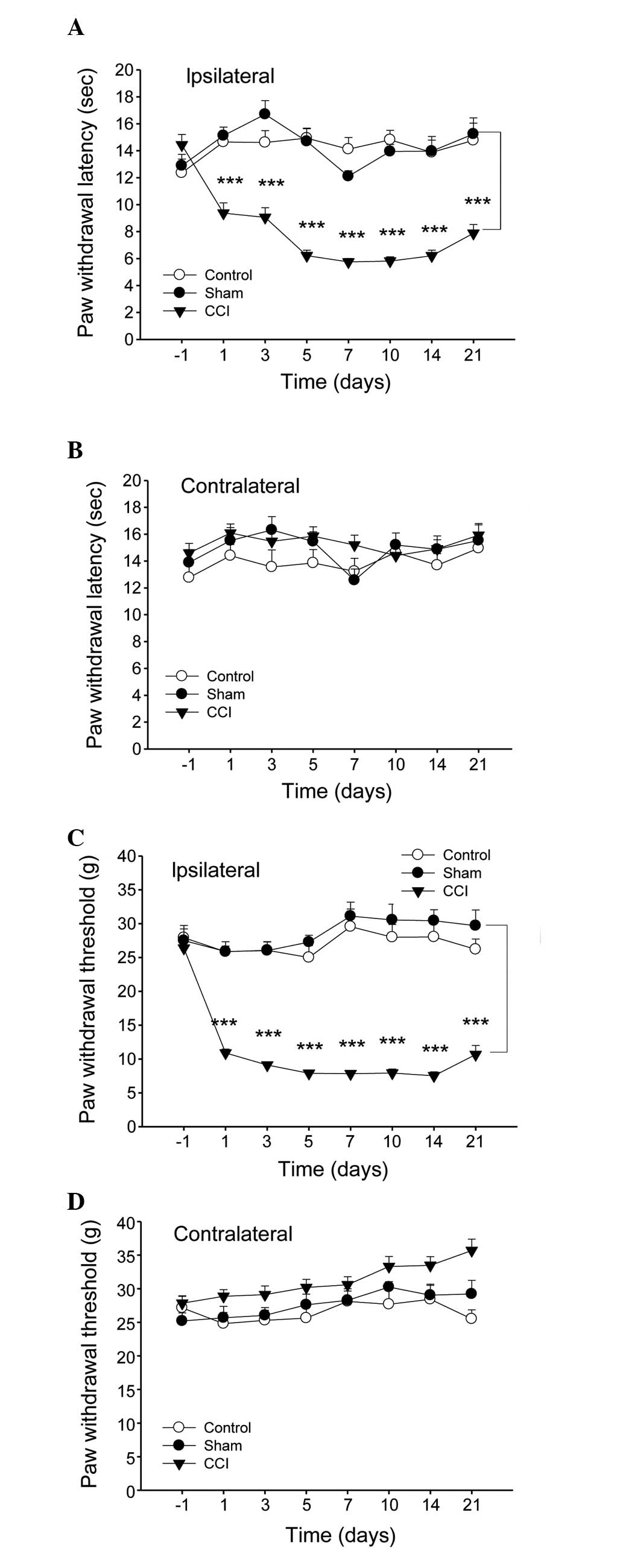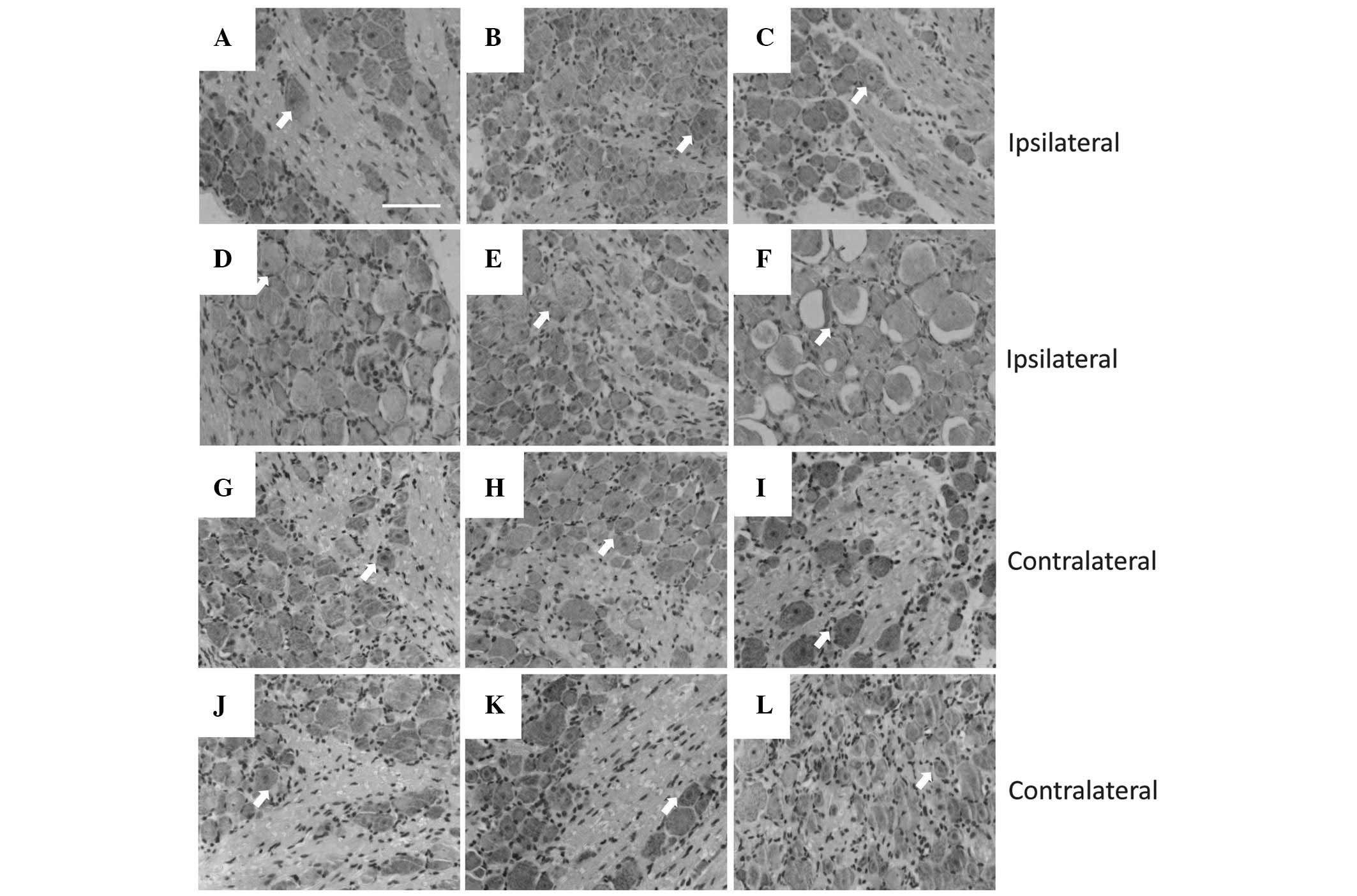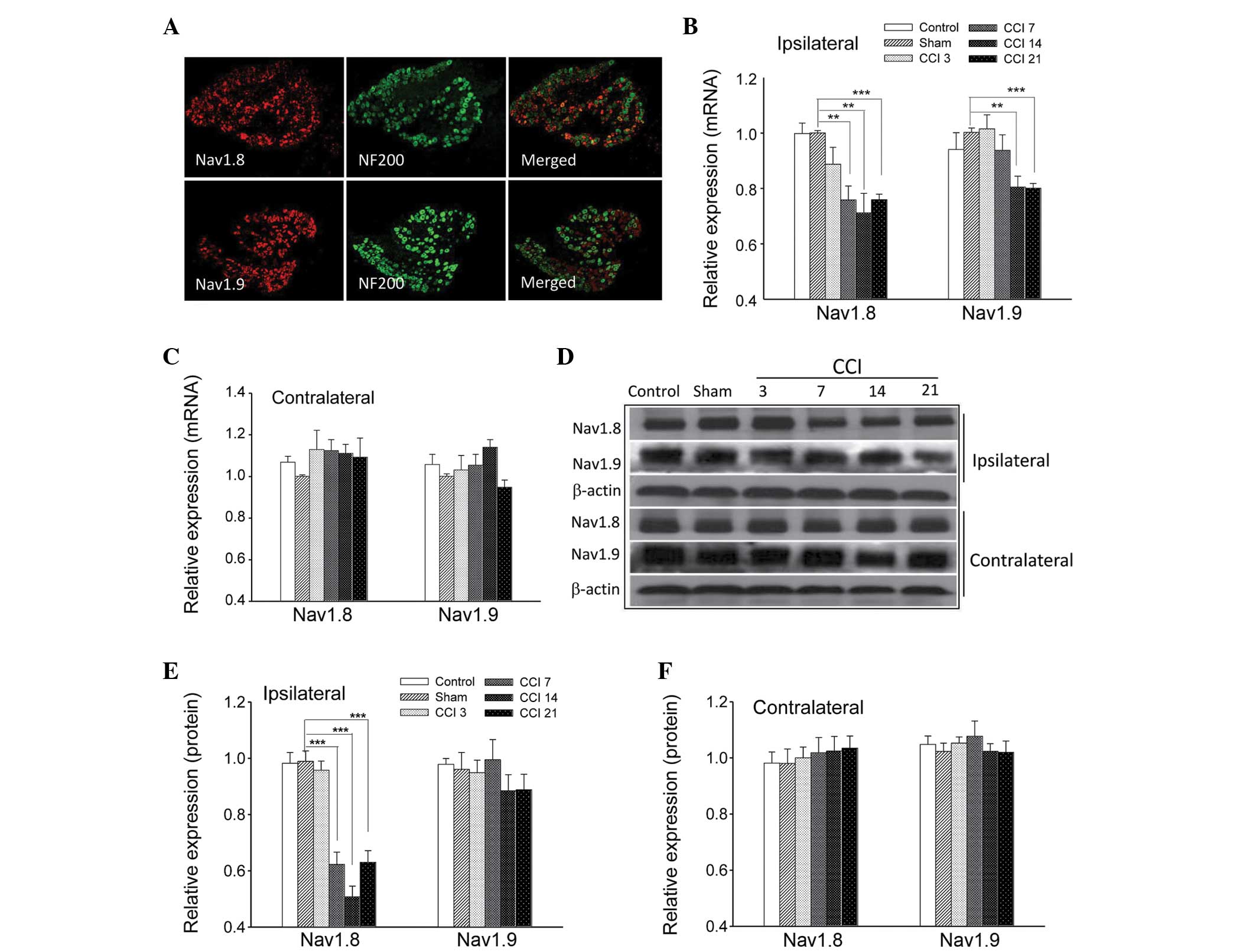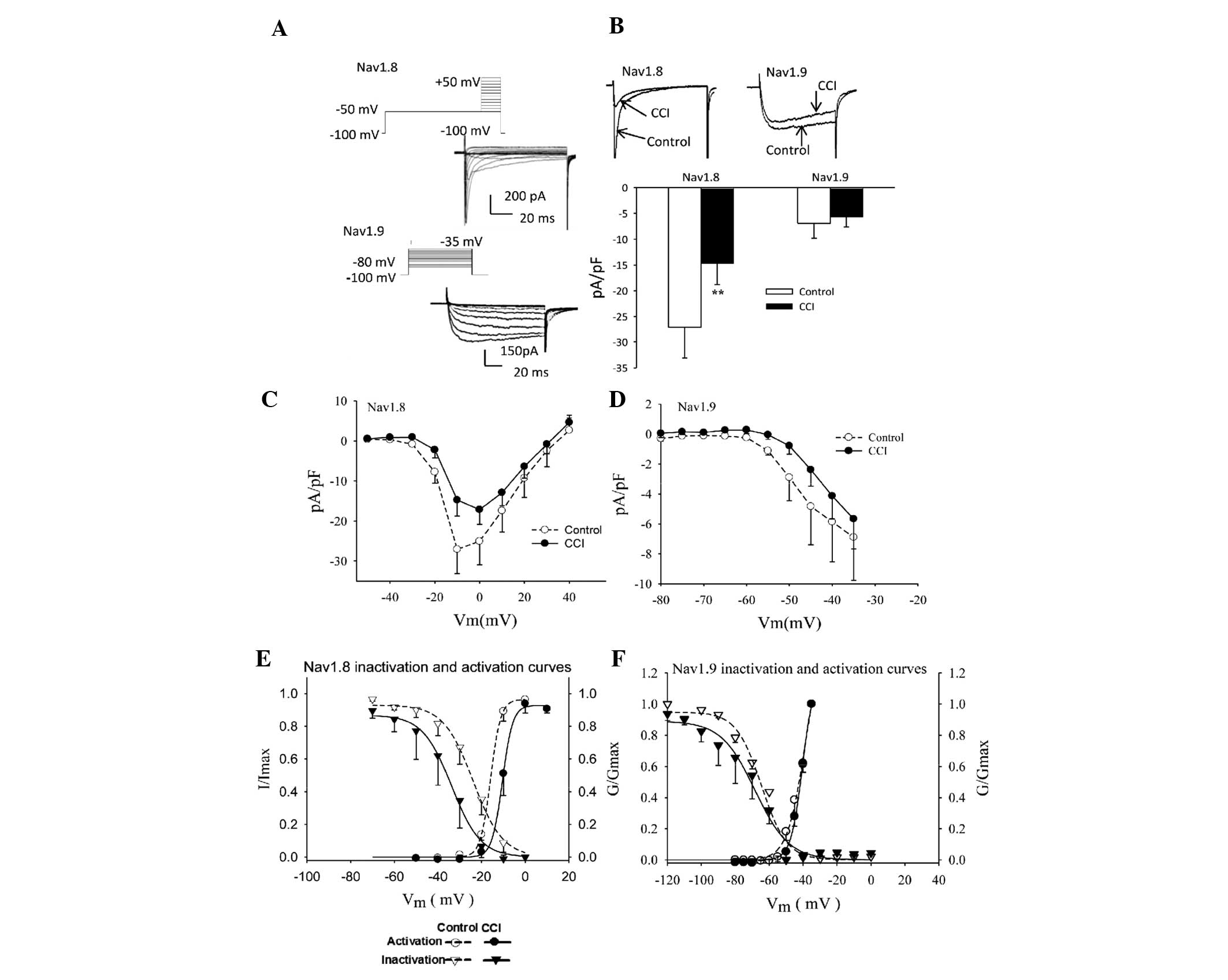|
1
|
Dib-Hajj SD, Binshtok AM, Cummins TR,
Jarvis MF, Samad T and Zimmermann K: Voltage-gated sodium channels
in pain states: role in pathophysiology and targets for treatment.
Brain Res Rev. 60:65–83. 2009. View Article : Google Scholar : PubMed/NCBI
|
|
2
|
Leo S, D'Hooge R and Meert T: Exploring
the role of nociceptor-specific sodium channels in pain
transmission using Nav1.8 and Nav1.9 knockout mice. Behav Brain
Res. 208:149–157. 2010. View Article : Google Scholar
|
|
3
|
Amir R, Kocsis JD and Devor M: Multiple
interacting sites of ectopic spike electrogenesis in primary
sensory neurons. J Neurosci. 25:2576–2585. 2005. View Article : Google Scholar : PubMed/NCBI
|
|
4
|
Joshi SK, Honore P, Hernandez G, et al:
Additive antinociceptive effects of the selective Nav1.8 blocker
A-803467 and selective TRPV1 antagonists in rat inflammatory and
neuropathic pain models. J Pain. 10:306–315. 2009. View Article : Google Scholar
|
|
5
|
Amaya F, Decosterd I, Samad TA, et al:
Diversity of expression of the sensory neuron-specific
TTX-resistant voltage-gated sodium ion channels SNS and SNS2. Mol
Cell Neurosci. 15:331–342. 2000. View Article : Google Scholar : PubMed/NCBI
|
|
6
|
Ho C and O'Leary ME: Single-cell analysis
of sodium channel expression in dorsal root ganglion neurons. Mol
Cell Neurosci. 46:159–166. 2011. View Article : Google Scholar
|
|
7
|
Blair NT and Bean BP: Roles of
tetrodotoxin (TTX)-sensitive Na+ current, TTX-resistant
Na+ current, and Ca2+ current in the action
potentials of nociceptive sensory neurons. J Neurosci.
22:10277–10290. 2002.PubMed/NCBI
|
|
8
|
Herzog RI, Cummins TR and Waxman SG:
Persistent TTX-resistant Na+ current affects resting
potential and response to depolarization in simulated spinal
sensory neurons. J Neurophysiol. 86:1351–1364. 2001.PubMed/NCBI
|
|
9
|
Dib-Hajj S, Black JA, Felts P and Waxman
SG: Down-regulation of transcripts for Na channel α-SNS in spinal
sensory neurons following axotomy. Proc Natl Acad Sci USA.
93:14950–14954. 1996. View Article : Google Scholar
|
|
10
|
Chen X, Pang RP, Shen KF, Zimmermann M,
Xin WJ, Li YY and Liu XG: TNF-α enhances the currents of voltage
gated sodium channels in uninjured dorsal root ganglion neurons
following motor nerve injury. Exp Neurol. 227:279–286. 2011.
View Article : Google Scholar
|
|
11
|
Lai J, Gold MS, Kim CS, Bian D, Ossipov
MH, Hunter JC and Porreca F: Inhibition of neuropathic pain by
decreased expression of the tetrodotoxin-resistant sodium channel,
NaV1.8. Pain. 95:143–152. 2002. View Article : Google Scholar : PubMed/NCBI
|
|
12
|
Gold MS, Weinreich D, Kim CS, Wang R,
Treanor J, Porreca F and Lai J: Redistribution of Na(V)1.8 in
uninjured axons enables neuropathic pain. J Neurosci. 23:158–166.
2003.PubMed/NCBI
|
|
13
|
Zhang XF, Zhu CZ, Thimmapaya R, et al:
Differential action potentials and firing patterns in injured and
uninjured small dorsal root ganglion neurons after nerve injury.
Brain Res. 1009:147–158. 2004. View Article : Google Scholar : PubMed/NCBI
|
|
14
|
Decosterd I, Ji RR, Abdi S, et al: The
pattern of expression of the voltage-gated sodium channels Na(v)1.8
and Na(v)1.9 does not change in uninjured primary sensory neurons
in experimental neuropathic pain models. Pain. 96:269–277. 2002.
View Article : Google Scholar : PubMed/NCBI
|
|
15
|
Wang H, Sun H, Della Penna K, et al:
Chronic neuropathic pain is accompanied by global changes in gene
expression and shares pathobiology with neurodegenerative diseases.
Neuroscience. 114:529–546. 2002. View Article : Google Scholar : PubMed/NCBI
|
|
16
|
Berta T, Poirot O, Pertin M, Ji RR,
Kellenberger S and Decosterd I: Transcriptional and functional
profiles of voltage-gated Na(+) channels in injured and
non-injured DRG neurons in the SNI model of neuropathic pain. Mol
Cell Neurosci. 37:196–208. 2008. View Article : Google Scholar
|
|
17
|
Sleeper AA, Cummins TR, Dib-Hajj SD, et
al: Changes in expression of two tetrodotoxin-resistant sodium
channels and their currents in dorsal root ganglion neurons after
sciatic nerve injury but not rhizotomy. J Neurosci. 20:7279–7289.
2000.PubMed/NCBI
|
|
18
|
Yu YQ, Zhao F, Guan SM and Chen J:
Antisense-mediated knockdown of Na(V)1.8, but not Na(V)1.9,
generates inhibitory effects on complete Freund's adjuvant-induced
inflammatory pain in rat. PloS ONE. 6:e198652011. View Article : Google Scholar : PubMed/NCBI
|
|
19
|
Bennett GJ and Xie YK: A peripheral
mononeuropathy in rat that produces disorders of pain sensation
like those seen in man. Pain. 33:87–107. 1988. View Article : Google Scholar : PubMed/NCBI
|
|
20
|
Li X, Kang L, Li G, et al: Intrathecal
leptin inhibits expression of the P2X2/3 receptors and alleviates
neuropathic pain induced by chronic constriction sciatic nerve
injury. Mol Pain. 9:65–73. 2013. View Article : Google Scholar : PubMed/NCBI
|
|
21
|
Lu Y and Westlund KN: Gabapentin
attenuates nociceptive behaviors in an acute arthritis model in
rats. J Pharmacol Exp Ther. 290:214–219. 1999.PubMed/NCBI
|
|
22
|
Gao YH, Chen SP, Wang JY, Qiao LN, Meng
FY, Xu QL and Liu JL: Differential proteomics analysis of the
analgesic effect of electroacupuncture intervention in the
hippocampus following neuropathic pain in rats. BMC Complement
Altern Med. 12:241–251. 2012. View Article : Google Scholar : PubMed/NCBI
|
|
23
|
Tu WZ, Cheng RD, Cheng B, et al: Analgesic
effect of electroacupuncture on chronic neuropathic pain mediated
by P2X3 receptors in rat dorsal root ganglion neurons. Neurochem
Int. 60:379–386. 2012. View Article : Google Scholar : PubMed/NCBI
|
|
24
|
Qiu F, Jiang Y, Zhang H, Liu Y and Mi W:
Increased expression of tetrodotoxin-resistant sodium channels
Nav1.8 and Nav1.9 within dorsal root ganglia in a rat model of bone
cancer pain. Neurosci Lett. 512:61–66. 2012. View Article : Google Scholar : PubMed/NCBI
|
|
25
|
Maingret F, Coste B, Padilla F, Clerc N,
Crest M, Korogod SM and Delmas P: Inflammatory mediators increase
Nav1.9 current and excitability in nociceptors through a coincident
detection mechanism. J Gen Physiol. 131:211–225. 2008. View Article : Google Scholar : PubMed/NCBI
|
|
26
|
McKay Hart A, Brannstrom T, Wiberg M and
Terenghi G: Primary sensory neurons and satellite cells after
peripheral axotomy in the adult rat: timecourse of cell death and
elimination. Exp Brain Res. 142:308–318. 2002. View Article : Google Scholar : PubMed/NCBI
|
|
27
|
Ueda H: Molecular mechanisms of
neuropathic pain-phenotypic switch and initiation mechanisms.
Pharmacol Ther. 109:57–77. 2006. View Article : Google Scholar
|
|
28
|
Latremoliere A and Woolf CJ: Central
sensitization: a generator of pain hypersensitivity by central
neural plasticity. J Pain. 10:895–926. 2009. View Article : Google Scholar : PubMed/NCBI
|
|
29
|
Zhao ZQ: Neural mechanism underlying
acupuncture analgesia. Prog Neurobiol. 85:355–375. 2008. View Article : Google Scholar : PubMed/NCBI
|
|
30
|
Abbas N, Gaudioso-Tyzra C, Bonnet C, et
al: The scorpion toxin Amm VIII induces pain hypersensitivity
through gain-of-function of TTX-sensitive Na+ channels.
Pain. 154:1204–1215. 2013. View Article : Google Scholar : PubMed/NCBI
|
|
31
|
Garrison SR, Weyer AD, Barabas ME, Beutler
BA and Stucky CL: A gain-of-function voltage-gated sodium channel
1.8 mutation drives intense hyperexcitability of A- and C-fiber
neurons. Pain. 155:896–905. 2014. View Article : Google Scholar : PubMed/NCBI
|


















